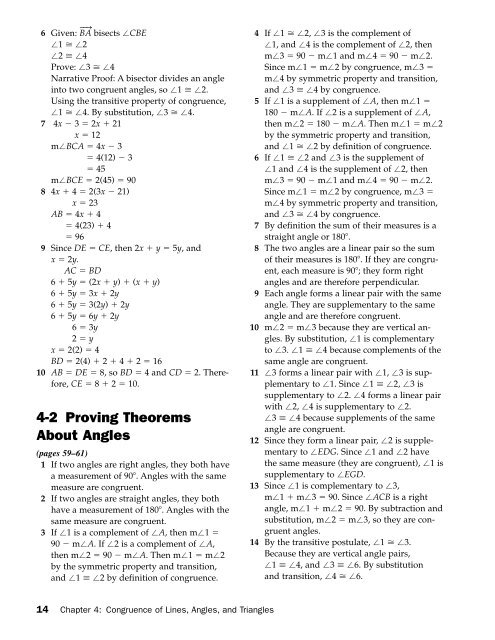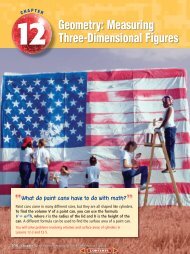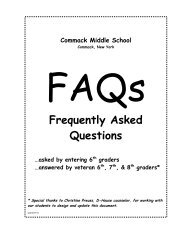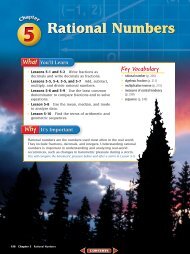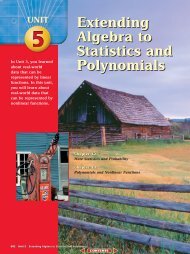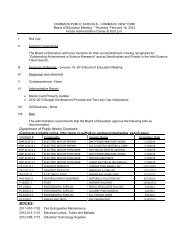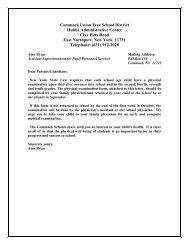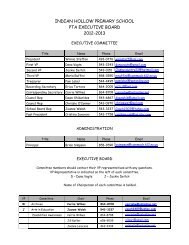Preparing for the Regents Examination Geometry, AK
Preparing for the Regents Examination Geometry, AK
Preparing for the Regents Examination Geometry, AK
You also want an ePaper? Increase the reach of your titles
YUMPU automatically turns print PDFs into web optimized ePapers that Google loves.
6 Given: BA bisects CBE<br />
1 2<br />
2 4<br />
Prove: 3 4<br />
Narrative Proof: A bisector divides an angle<br />
into two congruent angles, so 1 2.<br />
Using <strong>the</strong> transitive property of congruence,<br />
1 4. By substitution, 3 4.<br />
7 4x 3 2x 21<br />
x 12<br />
mBCA 4x 3<br />
4(12) 3<br />
45<br />
mBCE 2(45) 90<br />
8 4x 4 2(3x 21)<br />
x 23<br />
AB 4x 4<br />
4(23) 4<br />
96<br />
9 Since DE CE, <strong>the</strong>n 2x y 5y, and<br />
x 2y.<br />
AC BD<br />
6 5y (2x y) (x y)<br />
6 5y 3x 2y<br />
6 5y 3(2y) 2y<br />
6 5 y 6y 2y<br />
6 3y<br />
2 y<br />
x 2(2) 4<br />
BD 2(4) 2 4 2 16<br />
10 AB DE 8, so BD 4 and CD 2. There<strong>for</strong>e,<br />
CE 8 2 10.<br />
4-2 Proving Theorems<br />
About Angles<br />
(pages 59–61)<br />
1 If two angles are right angles, <strong>the</strong>y both have<br />
a measurement of 90. Angles with <strong>the</strong> same<br />
measure are congruent.<br />
2 If two angles are straight angles, <strong>the</strong>y both<br />
have a measurement of 180. Angles with <strong>the</strong><br />
same measure are congruent.<br />
3 If 1 is a complement of A, <strong>the</strong>n m1 <br />
90 mA. If 2 is a complement of A,<br />
<strong>the</strong>n m2 90 mA. Then m1 m2<br />
by <strong>the</strong> symmetric property and transition,<br />
and 1 2 by definition of congruence.<br />
14 Chapter 4: Congruence of Lines, Angles, and Triangles<br />
4 If 1 2, 3 is <strong>the</strong> complement of<br />
1, and 4 is <strong>the</strong> complement of 2, <strong>the</strong>n<br />
m3 90 m1 and m4 90 m2.<br />
Since m1 m2 by congruence, m3 <br />
m4 by symmetric property and transition,<br />
and 3 4 by congruence.<br />
5 If 1 is a supplement of A, <strong>the</strong>n m1 <br />
180 mA. If 2 is a supplement of A,<br />
<strong>the</strong>n m2 180 mA. Then m1 m2<br />
by <strong>the</strong> symmetric property and transition,<br />
and 1 2 by definition of congruence.<br />
6 If 1 2 and 3 is <strong>the</strong> supplement of<br />
1 and 4 is <strong>the</strong> supplement of 2, <strong>the</strong>n<br />
m3 90 m1 and m4 90 m2.<br />
Since m1 m2 by congruence, m3 <br />
m4 by symmetric property and transition,<br />
and 3 4 by congruence.<br />
7 By definition <strong>the</strong> sum of <strong>the</strong>ir measures is a<br />
straight angle or 180.<br />
8 The two angles are a linear pair so <strong>the</strong> sum<br />
of <strong>the</strong>ir measures is 180. If <strong>the</strong>y are congruent,<br />
each measure is 90; <strong>the</strong>y <strong>for</strong>m right<br />
angles and are <strong>the</strong>re<strong>for</strong>e perpendicular.<br />
9 Each angle <strong>for</strong>ms a linear pair with <strong>the</strong> same<br />
angle. They are supplementary to <strong>the</strong> same<br />
angle and are <strong>the</strong>re<strong>for</strong>e congruent.<br />
10 m2 m3 because <strong>the</strong>y are vertical angles.<br />
By substitution, 1 is complementary<br />
to 3. 1 4 because complements of <strong>the</strong><br />
same angle are congruent.<br />
11 3 <strong>for</strong>ms a linear pair with 1, 3 is supplementary<br />
to 1. Since 1 2, 3 is<br />
supplementary to 2. 4 <strong>for</strong>ms a linear pair<br />
with 2, 4 is supplementary to 2.<br />
3 4 because supplements of <strong>the</strong> same<br />
angle are congruent.<br />
12 Since <strong>the</strong>y <strong>for</strong>m a linear pair, 2 is supplementary<br />
to EDG. Since 1 and 2 have<br />
<strong>the</strong> same measure (<strong>the</strong>y are congruent), 1 is<br />
supplementary to EGD.<br />
13 Since 1 is complementary to 3,<br />
m1 m3 90. Since ACB is a right<br />
angle, m1 m2 90. By subtraction and<br />
substitution, m2 m3, so <strong>the</strong>y are congruent<br />
angles.<br />
14 By <strong>the</strong> transitive postulate, 1 3.<br />
Because <strong>the</strong>y are vertical angle pairs,<br />
1 4, and 3 6. By substitution<br />
and transition, 4 6.


